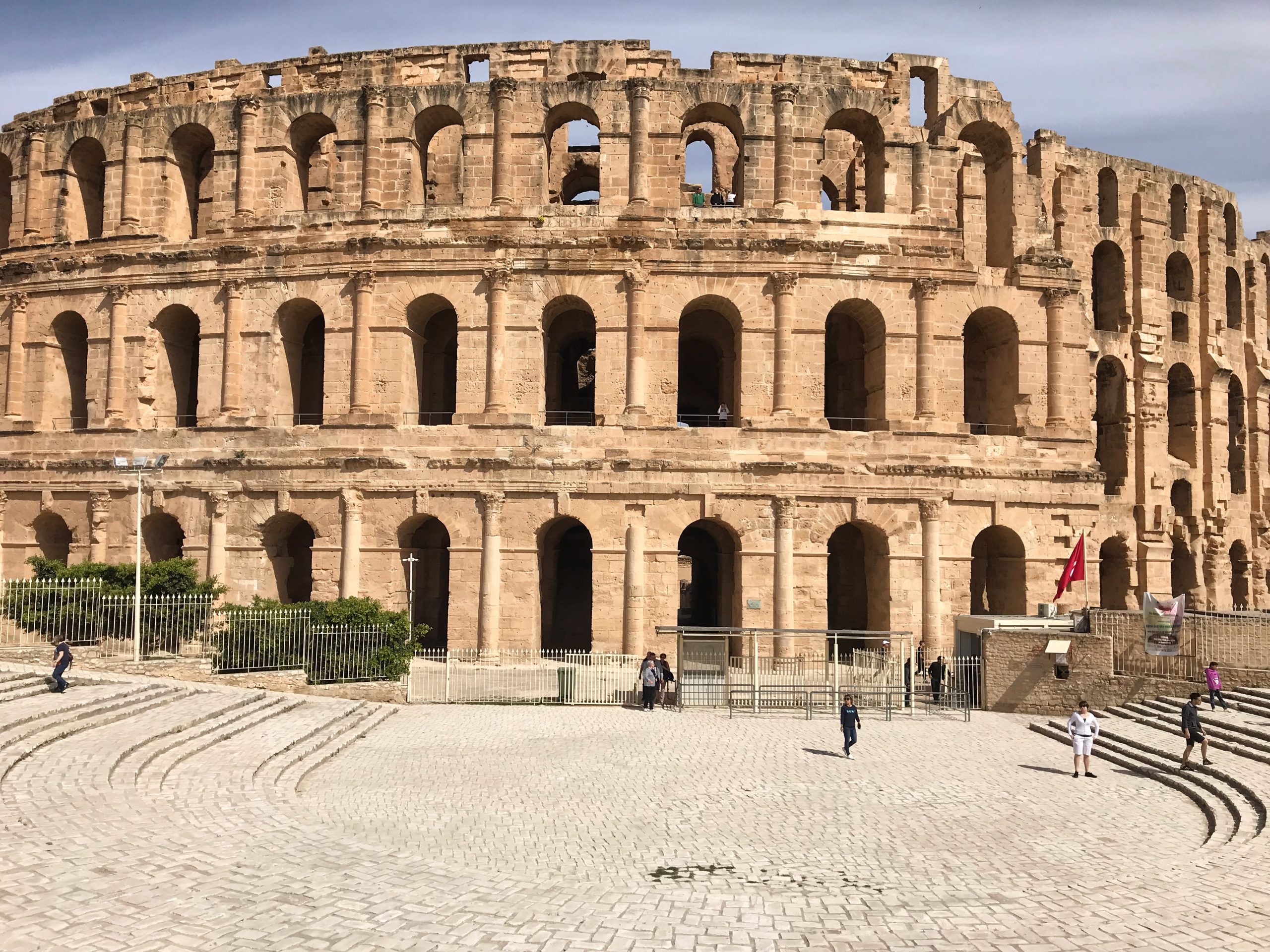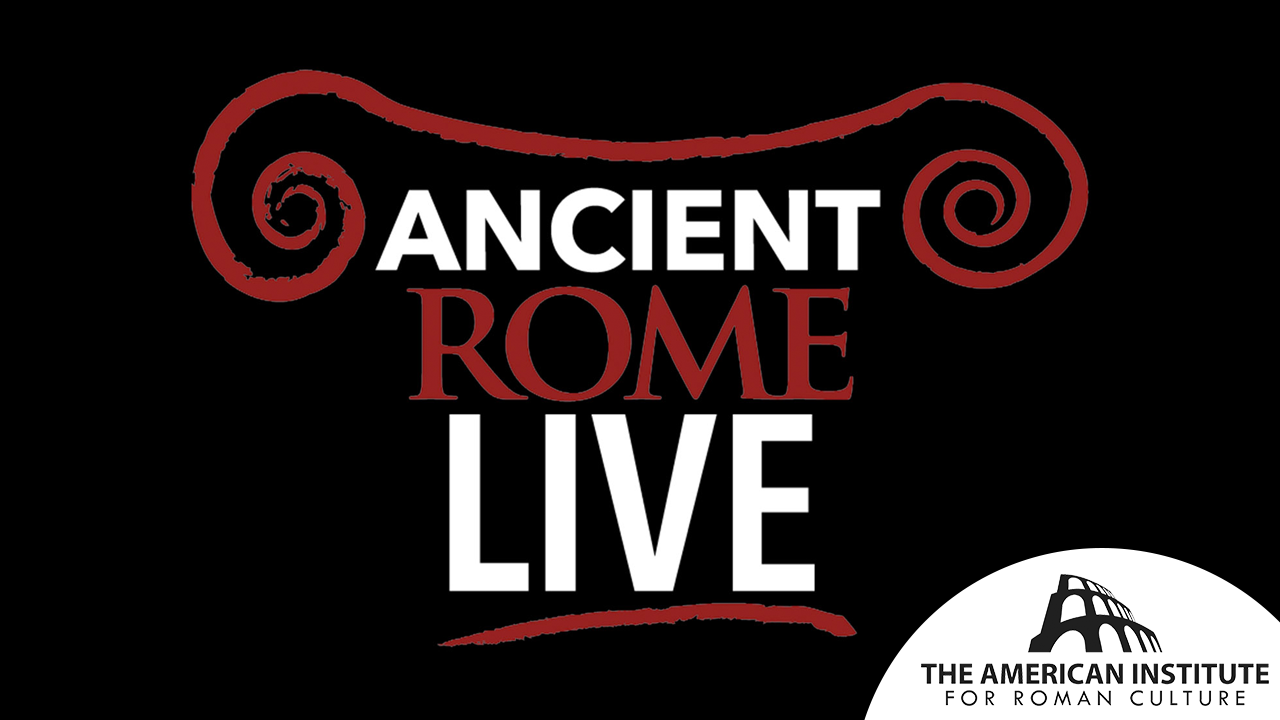In the ancient village of Thysdrus (the modern city of El Djem, Tunisia), the amphitheater of El Djem was constructed in the 3rd century CE. During the Severan Period (between the 2nd and 3rd centuries CE), the city flourished as a result of its strategic and transitory location between the coast and the interior, the cultivation of olive trees, and the production and trade of grains and olive oil.
The amphitheater of El Djem was the third amphitheater to be constructed in the city and is considered to be the largest amphitheater ever built in Africa. It is one of the few monuments of its kind and is unique in the African continent, as it was built on flat ground rather than against a hillside. The monument at El Djem is one of the best examples of Roman amphitheater design, nearly on par with the Colosseum in Rome.
The amphitheater of El Djem features massive sculpted protomes of Greco-Roman deities, decorating the spandrels between the façade’s arches. A protome is an architectural adornment carved to resemble the head and torso of a human or animal figure. Protomes are also featured on the amphitheaters of Capua and Carthage.
The amphitheater of El Djem is freestanding, made completely of stone blocks, and has no foundations. This magnificent structure is one of the best preserved gladiator arenas from the entire Roman period.
The monument’s circumference is 427 meters, creating an arena floor of 64 by 39 meters. The external axes are 148 by 122 meters, and the full height of the structure is approximately 36 meters. It would have been able to seat 30,000 to 35,000 people (which can be compared to the seating capacity of the Colosseum: 50,000 people). The hypogeum (meaning “underground”) consisted of two vaulted galleries with cells and an impressive set of tunnels for animals and gladiators.
During the Middle Ages, the amphitheater was used as a fortification to defend against Arab invaders and vandals from the 7th century CE until the Tunisian Revolution in 1695. Around this time, a significant portion of the external wall was dismantled.
After being added to the UNESCO World Heritage List in 1979, the El Djem amphitheater underwent restoration directed by Jean-Claude Golvin. Since this initial restoration, the National Heritage Institute has conducted a number of restricted preservation initiatives. The amphitheater still dominates the city’s skyline and serves as a venue for musical performances, including the Symphonic Music Festival in 2012.
References:
- David Bomgardner, “The Story of the Roman Amphitheatre”, (Routledge, 2000) p. 146-151
- Konstantin Nossov, “Gladiator: The Complete Guide to Ancient Rome’s Bloody Fighters”,(Lyons Press, 2011) p. 129-130
- “Amphitheatre of El Jem”, UNESCO, 5 May 2016.
- “The Amphitheatre of Thysdrus (El-Jem)” Agency of the Development of National Heritage and Cultural Promotion , Republic of Tunisia
- Lézine, H. Slim, J. Salomonson in CahTun (1960) 29-61PI; L. Foucher, La maison de la procession dionysiaque à El Jem (1963)
- The Princeton encyclopedia of classical sites. Stillwell, Richard. MacDonald, William L. McAlister, Marian Holland. Princeton, N.J. Princeton University Press. 1976.
- Dr. Imen Regaya, Dr. Najoua Tobji, Dr. Anis Karaa, “Les Actes du colloque, Rencontre el Jem Patrimoine et Développment Local Inteux et Déris”, 2019.
Read More
The amphitheater of El Djem was the third amphitheater to be constructed in the city and is considered to be the largest amphitheater ever built in Africa. It is one of the few monuments of its kind and is unique in the African continent, as it was built on flat ground rather than against a hillside. The monument at El Djem is one of the best examples of Roman amphitheater design, nearly on par with the Colosseum in Rome.
The amphitheater of El Djem features massive sculpted protomes of Greco-Roman deities, decorating the spandrels between the façade’s arches. A protome is an architectural adornment carved to resemble the head and torso of a human or animal figure. Protomes are also featured on the amphitheaters of Capua and Carthage.
The amphitheater of El Djem is freestanding, made completely of stone blocks, and has no foundations. This magnificent structure is one of the best preserved gladiator arenas from the entire Roman period.
The monument’s circumference is 427 meters, creating an arena floor of 64 by 39 meters. The external axes are 148 by 122 meters, and the full height of the structure is approximately 36 meters. It would have been able to seat 30,000 to 35,000 people (which can be compared to the seating capacity of the Colosseum: 50,000 people). The hypogeum (meaning “underground”) consisted of two vaulted galleries with cells and an impressive set of tunnels for animals and gladiators.
During the Middle Ages, the amphitheater was used as a fortification to defend against Arab invaders and vandals from the 7th century CE until the Tunisian Revolution in 1695. Around this time, a significant portion of the external wall was dismantled.
After being added to the UNESCO World Heritage List in 1979, the El Djem amphitheater underwent restoration directed by Jean-Claude Golvin. Since this initial restoration, the National Heritage Institute has conducted a number of restricted preservation initiatives. The amphitheater still dominates the city’s skyline and serves as a venue for musical performances, including the Symphonic Music Festival in 2012.
References:
David Bomgardner, “The Story of the Roman Amphitheatre”, (Routledge, 2000) p. 146-151
Konstantin Nossov, “Gladiator: The Complete Guide to Ancient Rome’s Bloody Fighters”,(Lyons Press, 2011) p. 129-130
“Amphitheatre of El Jem”, UNESCO, 5 May 2016.
“The Amphitheatre of Thysdrus (El-Jem)” Agency of the Development of National Heritage and Cultural Promotion , Republic of Tunisia
- Lézine, H. Slim, J. Salomonson in CahTun (1960) 29-61PI; L. Foucher, La maison de la procession dionysiaque à El Jem (1963)
The Princeton encyclopedia of classical sites. Stillwell, Richard. MacDonald, William L. McAlister, Marian Holland. Princeton, N.J. Princeton University Press. 1976.
Dr. Imen Regaya, Dr. Najoua Tobji, Dr. Anis Karaa, “Les Actes du colloque, Rencontre el Jem Patrimoine et Développment Local Inteux et Déris”, 2019.
This content is brought to you by The American Institute for Roman Culture, a 501(C)3 US Non-Profit Organization.
Please support our mission to aid learning and understanding of ancient Rome through free-to-access content by donating today.
Cite This Page
Cite this page as: Darius Arya, The American Institute for Roman Culture, “El Djem” Ancient Rome Live. Last modified 04/11/2023. https://ancientromelive.org/el-djem/
License
Created by The American Institute of Roman Culture, published on 10/24/2019 under the following license: Creative Commons: Attribution-NonCommercial-ShareAlike. This license lets others remix, tweak, and build upon this content non-commercially, as long as they credit the author and license their new creations under the identical terms. Please note that content linked from this page may have different licensing terms.



